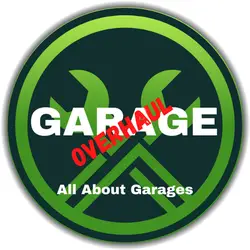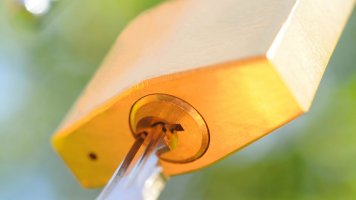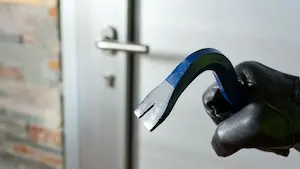How to Keep Vermins Out of the Garage Part 1
This post contains affiliate links.
Do you see vermins or signs of vermins in your garage? Most are destructive to your property or dangerous to you or your family members or pets. Let’s look at the most common household and garage vermins and how to get rid of them.
Most common garage vermins include mice, rats, maggots, flies, moths, mosquitoes, cockroaches, crickets, snakes, birds, and spiders.
This part 1 includes: mice, rats, maggots, flies, and moths.
Part 2 is here and includes: mosquitoes, cockroaches, crickets, snakes, birds, and spiders.
Mice
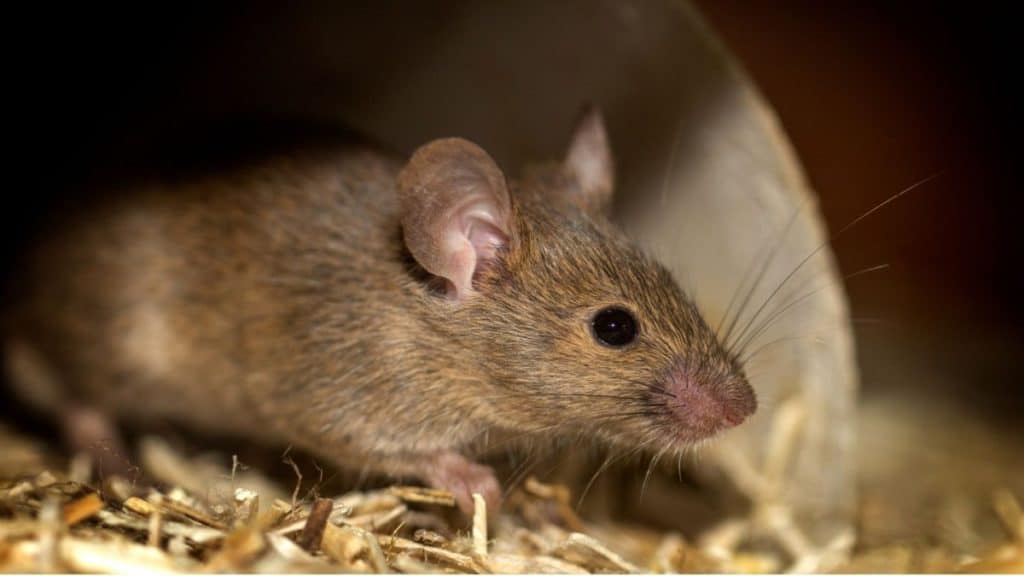
Mice are a little but destructive force. They will chew and eat almost anything and can carry diseases. In North America, breathing dust that has come in contact with mouse excrement has been linked to different viruses. They will also chew electrical wiring, which is a fire hazard.
Try to identify what type of mouse you are dealing with.
House Mice
- Are brown, black, grey. The tail has only a thin covering of hair.
- As the name says, house mice are the most common.
Field Mice
- Brown or grey and have white feet and underbelly.
- Smaller than house mice with a shorter tail.
Signs of Mice in Your Garage
Telltale signs of mice in the garage include smell, droppings, grease rubs, chew marks, and sounds. Also, your pets might be on high alert near where the mice are.
Unusual Smell
Mouse pee has a noticeable strong odor—a bit like ammonia. If you smell something that has no explanation, it might be mouse urine. You may also smell decomposing mouse body in a wall or ceiling cavity.
Mice Droppings
Droppings are small and dark. Around 0.20 inch or 5mm long
Grease Rubs
Mice have glands that produce oil for their coats. When mice move around, the oil combines with hair and dirt, and it will leave marks against where ever they touch.
Chew Marks
Chewed up cardboard boxes or holes in them. Holes in furnishing. Mice like to chew almost everything, even electric wires. This is a clear sign of mice infestation.
Sounds
You hear mice scampering or scratching or other mice-like sounds. Also, your dog or cat might be on high alert in some areas.
Organizing and cleaning the garage can reveal unwanted house quest like mice that like hiding.
Why Do I Have Mice in My Garage?
Mice look for food, water, warmth, shelter from predators, and nest supplies.
Food
- If you store pet food or your own food in the garage, then mice are after a free treat.
- Mice like to eat fruits, seeds, and grains but will eat almost anything.
Water
Most garages have damp areas or little water puddles, and mice drink from them.
Warmth
Mice seek warmth during the nights, especially in winter months, even in warm climates where it might get a little bit chilly at night. Even if your garage isn’t heated. Mice like to stay indoors. They are known to even go after the heat from the vehicle’s engine and make a nest in the air filter box.
Nest supplies
Mice like to build a nest from easily chewable materials like boxes and insulation. Garages have plenty of nest-building materials for mice. Mice also want to hide from predators in places they think are unreachable, like a cardboard box.
How to Keep Mice Out of the Garage
The most effective way to keep mice out of the garage is to clean and organize the garage. Remove or seal food sources and fix water leaks and seal all the access points. Consider also using repellents and traps.
Live Traps
Are bated traps which attract mouses. Once the mouse goes in, the trap is sprung, and the mice are trapped unharmed.
You can trap live mouses if you wish, but they might come just back when you release them into the wild. Different studies have shown that mice will travel as far as two miles to a place they know contains food, water, and shelter. So you have to drive pretty far to release them, so they cant find a way back to your house. If you are willing to see all the trouble, check the traps often and drive a live mouse far away to be released. Then you might consider live traps(paid link).
Traditional Traps
These will kill the mouse. Place the traps along with the garage under shelves, corners, rafters, and walls. Mice often follow walls when traveling, so anywhere near a wall is good.
Check the traps daily until all the mice are gone.
Glue Traps
Glue traps will not kill the mice immediately and will let them suffer unreasonably much. So traditional traps are a much better way to deal with mice.
Electronic Traps
Tunnel-shaped traps lure the mice inside with bait and shock them with a charge of 7,000 volts, killing them instantly. These traps use C batteries, and the shock isn’t strong enough to harm children or dogs and cats.
Find popular mouse traps at Amazon
Poisons
Poison may be lethal to dogs and cats. Also, kids might put the poison accidentally in their mouths. So be very careful with poisons.(paid link)
There are also traps with poison, so the poison is not so easily accessed by pets.
Some bait stations include poisonous and thirst-producing pellets that make the mice seek water from outside where it dies. (make sure there are no water source in the garage first)
Never set poison outdoors where squirrels and pets will eat them. Indoor mice that are killed with poison might die in the walls.
Repellents
Repellents(paid link) only work if you don’t have mice already in the garage. But if your garage is mice free zone, repellents are an excellent way to prevent mice from making a home.
- Spray repellent around the garage perimeter. You can buy ready-to-use repellents or try making your own.
- Hot chili sauce (1-3 tablespoon) (hotter the better) is excellent combined with water(gallon) and with some laundry detergent (¼ cup). This mix is a natural poison-free repellent and won’t damage your neighbor pets.
- Peppermint is another good repellent. Buy some peppermint extract and mix it with water and spray it around the perimeter. You can also plant peppermint plants around the garage.
- You can also try essential oils or clove essential oil.
- The problem with chili and peppermint extract is that you have to re-spray them after heavy rainfall or dry season.
Seal Access Holes for Mice
Any hole larger than ¼ inch in diameter is enough to let the mice in because they can compress their bodies and squeeze through almost anything. So when there are no mice in your garage anymore is time to patch the holes. Use caulk and patching compounds. You can also put steel wool into the holes with caulk and patching compound. Mice cannot chew thru steel wool.
Go through all the walls, doors, windows, and screens, looking for the tiniest holes and cracks. Put screening in all the vents. Ensure the garage door is properly sealed from the sides and the bottom weather seal(paid link) is in good condition.
Exterminators
Sometimes is just time to call in the pros to take care of the problem. If you don’t have time or have done everything you can, and mice still live in your house or garage. Sometimes mice live deep inside the walls, so traps and repellents aren’t effective enough. Or the mice come back from time to time.
Prevention
- Clean, organize and declutter the garage, so the mice have no place to hide.
- Store food and pet food in plastic containers(paid link) so the mice cannot access and smell them anymore. Or move them out of the garage. Put anything in airtight plastic containers that mice could find appealing—bird food, straw, fertilizer.
- Keep the bird feeder far away from the house. It will attract rodents of all kinds.
- Seal the garbage bins and place a heavy rock at least to the lid. Try to keep garbage cans away from the garage and house.
- Cats will keep the rodents away. So consider getting one, especially if you live in rural areas.
Rats
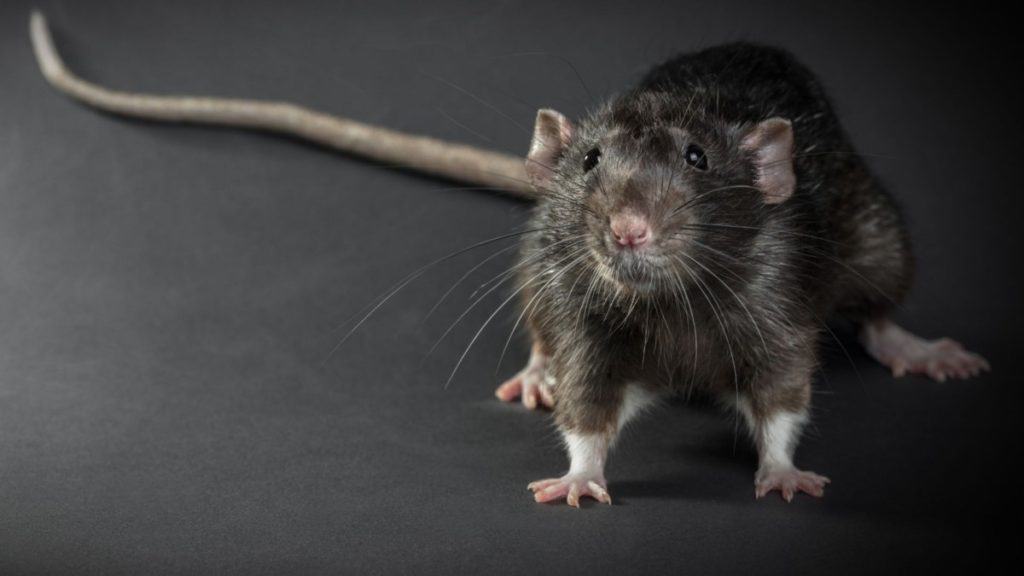
Rats are a nasty destructive force. They will chew and eat almost anything and can carry diseases. In North America, breathing dust that has come in contact with rat excrement has been linked to different viruses. They can also bite humans or animals. They will also chew electrical wiring, which is a fire hazard.
Try to identify what type of rat you are dealing with.
Norway Rat
- Large and bulky body. Brown fur. Brown underbelly. About 16 inches long.
Roof Rat
- Sleek and slim. Black fur. Gray Underbelly. About 14 inches long.
Signs of Rats in Your Garage
Rats are nocturnal and active at night.
Telltale signs of rats in the garage include smell, droppings, grease rubs, chew marks, and sounds. Also, your pets might be on high alert near where the rats are.
Norway Rats dig burrows where they live. They can block sewer lines and dig all over the foundation of houses.
Roof Rats chew wood and wires and climb fruit trees and eat the fruits.
Unusual Smell
Rat pee has a noticeable strong odor. A bit like ammonia. A bit musky. If you smell something that has no explanation, it might be rat urine. You may also smell decomposing rat body in a wall or ceiling cavity.
Rat Droppings
Droppings are shiny and black or dark brown. Around 1/2 – 3/4 of an inch long.
Grease Rubs
Rats have glands that produce oil for their coats. When rats move around, the oil combines with hair and dirt. It will leave marks against their touch.
Chew Marks
Chewed up cardboard boxes or holes in them. Holes in furnishing. Rat holes in next to solid objects. Rats like to chew almost everything, even electric wires. This is a clear sign of rat infestation.
Sounds
You hear rats scampering or scratching or other rat-like sounds. Also, your dog or cat might be on high alert in some areas.
Organizing and cleaning the garage can reveal unwanted house quests like rats that like hiding.
Why Do I Have Rats in My Garage?
Rats look for food, water, warmth, shelter from predators, and nest supplies.
Food
- If you store pet food or your own food in the garage, then rats are after a free treat.
- Rats like to eat fruits, plants, seeds, and grains but will eat almost anything like garbage and meat.
Water
Most garages have damp areas or little water puddles, and rats drink from them.
Warmth
Rats seek warmth during the nights, especially in winter months, even in warm climates where it might get a little bit chilly at night. Even if your garage isn’t heated. Rats like to stay indoors. They are known to even go after the heat from the vehicle’s engine and make a nest in the air filter box.
Nest Supplies
Rats like to build a nest from easily chewable materials like boxes and insulation. Garages have plenty of nest-building materials for rats. Rats also want to hide in lofts, attics, under eaves, and even in cavity walls.
How to Keep Rats Out of the Garage
The most effective way to keep rats out of the garage is to clean and organize the garage. Remove or seal food sources and fix water leaks and seal all the access points. Consider also using repellents and traps.
Live Traps
Bated traps attract rats. Once the rat goes in, the trap is sprung, and the rats are trapped unharmed.
You can trap live rats if you wish, but they might come just back when you release them into the wild. Different studies have shown that rats will travel as far as two to four miles to a place they know contains food, water, and shelter. So you have to drive pretty far to release them, so they cant find a way back to your house. If you are willing to see all the trouble, check the traps often and drive a live mouse far away to be released. Then you might consider live traps(paid link).
Traditional Traps
These will kill the rat. Place the traps along with the garage under shelves, corners, rafters, and walls. Rats often follow walls when traveling, so anywhere near a wall is good.
Check the traps daily until all the rats are gone.
Glue Traps
Glue traps will not kill the rat immediately and will let them suffer unreasonably much. So Traditional traps are a much better way to deal with rats.
Electronic Traps
Tunnel-shaped traps lure the rat inside with bait and shock them with a charge of 7,000 volts, killing them instantly. These traps use C batteries, and the shock isn’t strong enough to harm children or dogs and cats.
Check out popular rat traps at Amazon
Poisons
Poison and is very dangerous and may be lethal to dogs and cats. Also, kids might put the poison accidentally in their mouths. So be very careful with poisons(paid link).
There are also traps with poison, so the poison is not so easily accessed by pets.
Some bait stations include poisonous and thirst-producing pellets that make the rats seek water from outside where it dies. (make sure there are no water source in the garage first)
Never set poison outdoors where squirrels and pets will eat them. Indoor rats that are killed with poison might die in the walls.
Repellents
Repellents only work if you don’t have rats already in the garage. But if your garage is a rat-free zone, repellents are an excellent way to prevent rats from making a home.
Spray repellent around the garage perimeter. You can buy ready-to-use repellents(paid link) or try making your own.
Hot chili sauce (1-3 tablespoon) (hotter the better) is excellent combined with water(gallon) and with some laundry detergent (¼ cup). This mix is a natural poison-free repellent and won’t damage your neighbor pets.
Peppermint is another good repellent. Buy some peppermint extract and mix it with water and spray it around the perimeter. You can also plant peppermint plants around the garage.
You can also try essential oils or clove essential oil.
The problem with chili and peppermint extract is that you have to re-spray them after heavy rainfall or dry season.
Access Holes for Rats
Rats can slip into holes the size of a quarter. Because they can compress their bodies and squeeze through almost anything. So when there are no rats in your garage anymore is time to patch the holes. Use caulk and patching compounds. You can also put steel wool into the holes with caulk and patching compound. Rats cannot chew thru steel wool.
Go through all the walls, doors, windows, and screens, looking for the tiniest holes and cracks. Put screening in all the vents. Ensure the garage door is properly sealed from the sides and the bottom weather seal(paid link) is in good condition.
Exterminators
Sometimes it is just time to call in the pros to take care of the problem. If you don’t have time or have done everything you can, and rats still live in your house or garage. Sometimes rats live deep inside the walls and under the house. So traps and repellents aren’t effective enough. Or the rats come back from time to time.
Prevention
- Clean, organize and declutter the garage, so the rats have no place to hide.
- Store food and pet food in airtight plastic containers(paid link) so the rats cannot smell them anymore. Or move them out of the garage. Put anything in airtight plastic containers that rats could find appealing—bird food, straw, fertilizer.
- Keep the bird feeder far away from the house. It will attract rodents of all kinds.
- Seal the garbage bins and place a heavy rock at least to the lid. Try to keep garbage cans away from the garage and house.
- Cats will keep the rodents away. So consider getting one, especially if you live in rural areas.
Maggots
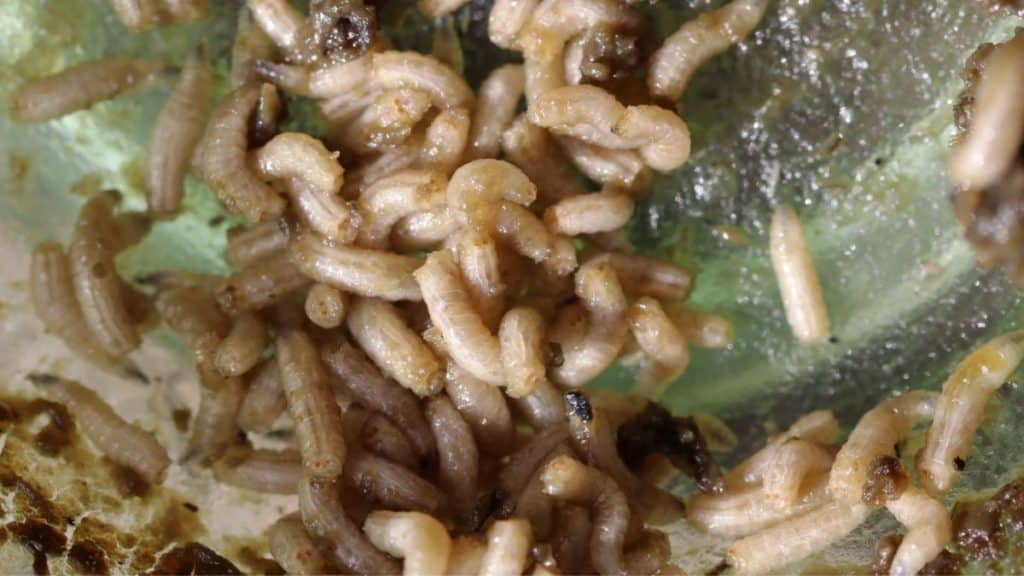
A maggot is a larva of a common fly. Maggots look a bit like worms. The female fly lays eggs, and eggs turn into maggots. Fly can live 15-30 days, and female fly can lay up to 500-2000 eggs.
Signs of Maggots in Your Garage
Maggots are usually found in trash bins in decaying organic matter. So if you see squirmy white worms in the trash, they are fly maggots.
Why Do I Have Maggots in My Garage?
Flies are everywhere and lay their eggs in organic trash. The female flies lay eggs on the rotting garbage, dead animal, or pet waste. Maggots emerge to feed on the decaying matter.
How to Keep Maggots Out of the Garage
Maggots will spend about 14-36 days eating before entering the pupal stage, where they transition into flies.
Maggots need a source of protein, usually meat. So taking care of trash gets rid of the maggots.
How to Get Rid of Maggots
Boiling Water – Pour boiling water over maggots. It will instantly kill them.
Freezing -Freeze the maggot container in an airtight container.
Bleach -Dilute bleach 50/50 with water and spray it on the maggots.
Lime, Salt, Vinegar – Mix any of these with water. And you got a maggot spray.
Insecticide – Almost any insecticide will work(paid link)
Diatomaceous earth – is non-toxic to pets and humans, but it kills insects by destroying their exoskeletons.(paid link)
Preventing
Clean the trash can with water and soap and coat the interior with a can of baking soda. It will prevent maggots from coming back. Use sealed cans and empty them regularly outside.
Flies
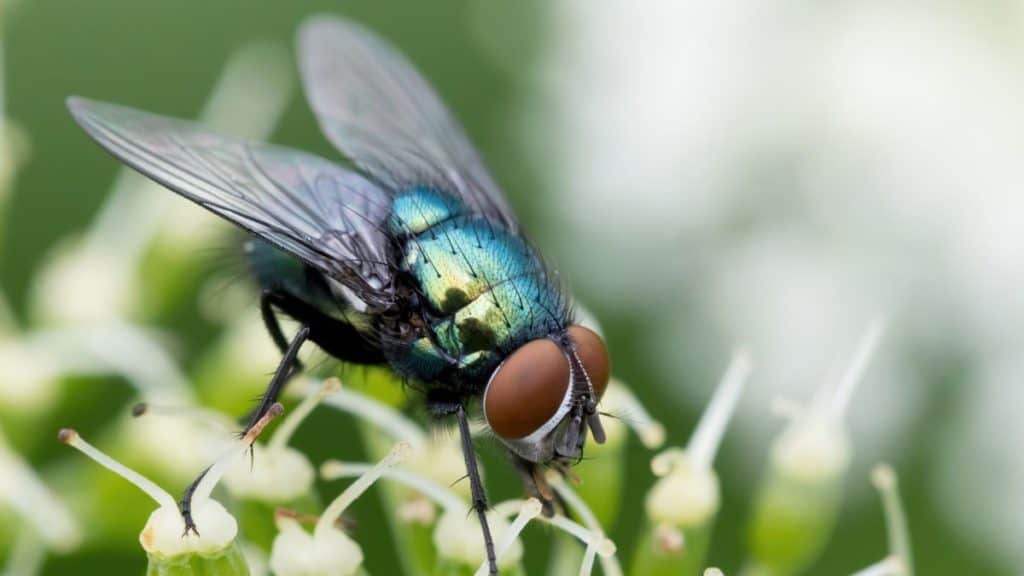
Fly can live 15-30 days, and female fly can lay up to 500-2000 eggs. Eggs turn into maggots.
A maggot is a larva of a common fly.
Signs of Flies in Your Garage
There are little buggers everywhere. In the house. On the porch. Almost surely in the garage.
Why Do I Have Flies In My Garage?
Flies are everywhere and lay their eggs in organic trash. The female flies lay eggs on the rotting garbage, dead animal, or pet waste. Maggots emerge to feed on the decaying matter. Maggots will spend about 14-36 days eating before entering the pupal stage, where they transition into flies.
Bright lights at night also attract flies.
How to Keep Flies Out of the Garage
Almost impossible when you open the door. Flies will fly in. But you can try repellents(paid link) and taking the trash out sooner than later.
Seal Access
Patch all the holes. Use caulk and patching compounds. Go through all the walls, doors, windows, and screens, looking for the tiniest holes and cracks. Put screening in all the vents. Ensure the garage door is properly sealed from the sides and the bottom weather seal(paid link) is in good condition.
Deal with the maggots first. Maggots are usually found in trash bins in decaying organic matter. So if you see squirmy white worms in the trash, they are fly maggots.
Maggots need a source of protein, usually meat. So taking care of trash gets rid of the maggots.
How to Get Rid of Maggots
Boiling Water
Pour boiling water over maggots. It will instantly kill them.
Freezing
Freeze the maggot container in an airtight container.
Bleach
Dilute bleach 50/50 with water and spray it on the maggots.
Lime, Salt, Vinegar
Mix any of these with water. And you got a maggot spray.
Insecticide
Almost any insecticide will work(paid link)
Diatomaceous earth is non-toxic to pets and humans, but it kills insects by destroying their exoskeletons.(paid link)
Preventing
Clean the trash can with water and soap and coat the interior with a can of baking soda. It will prevent maggots from coming back. Use sealed cans and empty them regularly outside.
Dealing With Flies
Natural Way
Plant some herbs and flowers in the garden and outside, including
- Basil
- Marigold
- Lavender
- Bay Leaves
- Mint
- Nasturtiums
Cayenne pepper and water mix. Spray the mixture around the garage.
Cinnamon – use cinnamon as an air freshener. Flies hate the smell.
Lavender, eucalyptus, peppermint, and lemongrass essential oils deter flies.
Vinegar and Dish Soap Trap
Use a shallow dish bowl or similar and add an inch or two of apple cider vinegar and a tablespoon of sugar. Next, add fruit-scented dish soap. Leave the trap uncovered or cover it with plastic wrap and poke a few holes in the plastic.
Insecticides work short-term with flies.
Traps
Light Traps
- When the flies try to get to the light, they get electrocuted or trapped, depending on the trap.
- Mount the traps away from entrances and windows and at least 5 feet from the floor.
Sticky Traps
Old classic. Sticky paper that attracts flies. It can be hung from the ceiling or laid down. Not very effective, but a good addition to other traps.
Find most popular fly traps at Amazon
Preventing Flies
- Seal all the holes and racks everywhere in the garage with caulk and patching compound and screen covers in vents.
- Don’t leave dirty dishes on the counter.
- Don’t leave grass clippings or leaves to decay out near the house.
- Clean up animal feces.
Moths
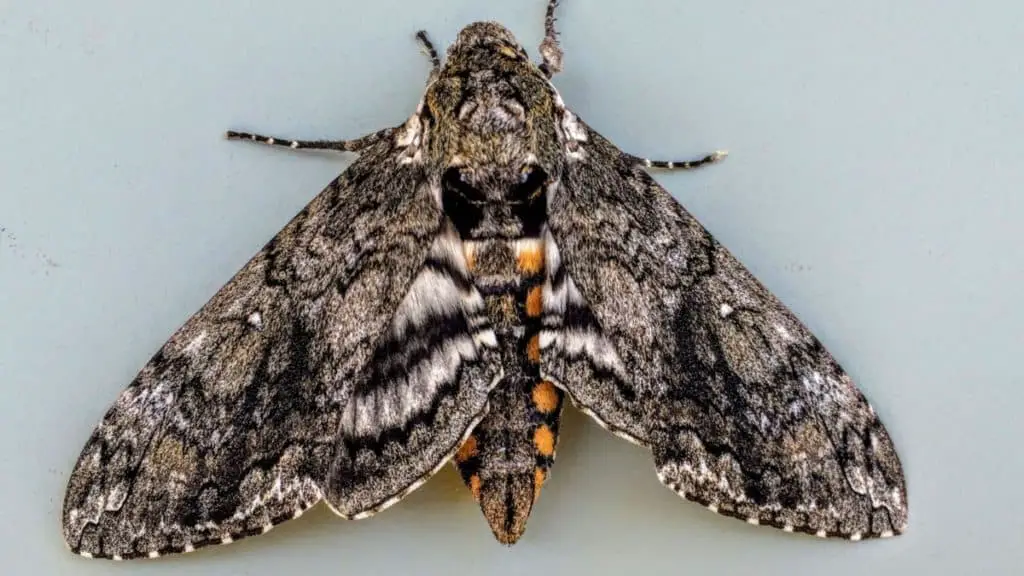
Nocturnal night butterfly. Pretty harmless but in large numbers annoying. Moth larvae are called caterpillars, and they make cocoons where they emerge as fully grown winged moths.
Caterpillars of moth can cause extensive damage to forest and fruit farms. Moth larvae can eat fabrics.
Signs of Moths in Your Garage
Telltale signs are ruined fabrics and larvae webbing, and tubes in the fabric.
- Tiny maggot-like larvae called moth caterpillar
- silken tubes where larvae live
- Silk cocoons where larvae emerge as moths
The eggs are so tiny they are almost unnoticeable, 0.019 inches or 0.5mm.
Moth eggs are white and often covered in webbing. There will be large numbers of them in a cluster.
They are usually found in soft undisturbed fabrics that contain keratin. Such as old unworn clothing.
Clothing Damage
Some moth larvae eat fabrics.
- Common Clothes Moth larvae – cause irregularly shaped holes in natural fabrics. Adults lay cream-colored eggs, which hatch into creamy white larvae.
- Case Bearing Clothes Moth larvae – create smaller, more regular-shaped holes in garments and textiles. The larvae are white with a brown head.
- Brown House Moth larvae – tend to prefer animal-based materials like feathers and leather. They are the most common type of house moth.
- White Shouldered House Moth larvae – scavenge on a wide range of food, so they are a little less damaging to textiles. They will make small circular holes in natural fibers. These moths tend to be rarer than other species.
If you notice random holes in your garments, look around for moth larvae and cocoons because they are likely nearby.
Why Do I Have Moths in My Garage?
Moths are especially attracted to light at night time, and if you keep the service or garage door open, there will be moths coming in.
The larvae eat fabrics such as fur, wool, and silk.
They also eat dried foods like nuts: grains, flour, and cereal. If there are holes in the packaging, moths or some other vermin are eating them. Throw the food out.
How to Keep Moths Out of the Garage
Almost impossible when you open the door. Moths are attracted by bright lights at nighttime. But you can try repellents.
Seal Access
Patch the holes. Use caulk and patching compounds. Go through all the walls, doors, windows, and screens, looking for the tiniest holes and cracks. Put screening in all the vents. Ensure the garage door is properly sealed from the sides and the bottom weather seal is in good condition.
Diatomaceous earth is non-toxic to pets and humans, but it kills insects by destroying their exoskeletons.(paid link)
- Put any fabrics and linen or anything that sort in airtight packs(paid link).
- Store food and grains etc., in airtight containers.
- Clean and organize the whole garage. Use a vacuum to remove adult moths and larvae.
- Moths prefer to lay their eggs in the dark, undisturbed areas.
- Wash or dry clean infected clothes.
- Use moth repellents(paid link)
- Don’t keep the doors open at night.
